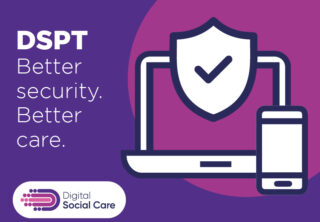Providing digital support for vulnerable young people
This piece has been written by Assistant Director Katy Burch. These are her observations and reflections around providing arms’ length (digital) support to young people during the Covid-19 crisis. It covers what help is currently available, what has been or could be developed to help meet needs and what is known about how to deliver targeted digital support.
Within days if not hours of the coronavirus lockdown, children’s social care services were galvanising support for the most vulnerable children and young people already known to be at risk of abuse or neglect. The UK Government has made available additional funding to respond to these families’ needs during the lockdown and, in many cases, social workers and targeted family support workers are continuing to visit and monitor risk within these households.
However, there is another more hidden group of vulnerable children and young people: those who are known to targeted early help services, but not in ‘priority cohorts’ for face-to-face support during the Covid-19 period, as well as those who are not known, but have become vulnerable perhaps because of well-reported increases in family conflict and parent alcohol misuse during lockdown. Their invisibility is exacerbated by being out of schools that remain closed to most pupils. Schools are only providing a service for children who are considered vulnerable because: they have an EHC plan, a Child in Need (or Child Protection) Plan; or who have been assessed as being on the edge of needing support from Children’s Social Care Services. However, this is mostly optional and not all families with eligible children are taking up this support. There is government guidance on who is eligible and what services should do if children who are eligible do not attend.
Even if these groups are identified as requiring specific help (for example through fresh referrals to Children’s Social Care Services or Multi-Agency Early Help Panels), how can services ensure that they are well supported, albeit mostly at arms’ length? This paper explores:
- What open access supports are available to help children and families?
- What more targeted supports have or can be developed to meet their needs?
- What is currently known about how to deliver targeted support digitally?
What open access supports are available for all children and families during this period?
Some online or telephone supports are continuing to be provided and/or adapted for a wider group of children and families who may be (becoming) vulnerable or who are just struggling in a normal way with significant changes to their lifestyle. They are being provided mostly by national voluntary sector organisations with a track record in arms’ length support. Many have adjusted their offer specially to support children during the lockdown. For example, Childline offers user-friendly ‘chunks’ of advice to children who are experiencing domestic abuse and / or may just feel overwhelmed or anxious about the virus. The NSPCC has more parent-directed materials on its website, for example “talking to children worried about the coronavirus”, “taking care of your mental health”, “supporting SEND children”, “arguments, conflict and family tension”. Barnardo’s have developed ‘advice hubs’ for adult and child / young person family members. Family Action are offering a ‘family line’ to support adult family members by telephone, text, email and webchat. Mind have a comprehensive list of online and other remote forms of support for young people on their website.
What more targeted supports have or can be developed for vunerable children and families?
Many providers of targeted family support, either of a general or a specialist nature, for example domestic abuse, have also been rapidly developing their offer during this period. A survey of 88 providers conducted by the Early Intervention Foundation in the first two weeks of lockdown identified that approximately three quarters were already making major adaptations to standard delivery (Martin, J et al. 2020), in particular by:
- Moving resources and programme content online
- Using phones
- Using messaging services such as WhatsApp
- Using video conferencing services such as Skype, Zoom and Microsoft Teams to deliver actual sessions
Some had also begun to redesign the content and format of specific interventions to make them easier to deliver remotely.
This has clearly been a huge leap forward for many providers as, prior to the lockdown, only about a third of all providers (including national providers) were delivering their programme predominantly through remote methods and in only 3% of cases were such programmes being delivered in this way on a one-to-one basis.
Case Study: Barnardo’s Cymru A whole family domestic abuse service run by Barnardo’s Cymru service in South East Wales has been busy over the last 4-5 week period “thinking a little differently about our offer”. Although not all young people and families are interested in a remote offer of support, the staff there are finding that some family members, notably adult perpetrators, have responded positively to an offer of one-to-one or group-based support using video calls or other forms of digital communication. Video calls are thought to be working best where service users are ready and keen to get stuck into actual sessions compared for example with newly referred family members who haven’t yet built up a level of trust. For example, the service has been able to deliver an adapted version of the Star Programme (for young people) and elements of the adult survivor and perpetrator programmes this way. Where sessional work is being provided (rather than just check in or crisis management communications), materials can be sent in advance to the participant via email or telephone (using photo shots) and discussed during the actual session. In adapting this material and their delivery of it, the service has been mindful of the need to consider literally where the service user is located, often within the family home, and, in particular, where content has the potential to trigger risky or unpredictable behaviours. Service managers are mindful that their primary duty is to help to manage risk and support behaviour management during the Covid period, rather than to achieve major behaviour change. |
What is known so far about how to deliver targeted support digitally?
A number of relatively-recently commissioned research studies with young people suggest that, although still considering family and friends to be fundamental to their wellbeing (Place2Be, 2019), more and more have used the internet to understand and navigate topics they’re nervous to ask about in person and to help them through a difficult time (UK Safer Internet Centre, 2019). Pre-coronavirus, what they reported looking for was a combination of face-to-face and digital support.
Anecdotally, providers are already identifying some benefits of digitally delivered key worker or therapy sessions for young people capable of participating in this way, for example, that it can enable a young person to make choices they might not have when meeting an adult worker face-to-face and that it might provide a more regular form of support (better for some than more irregular face-to-face sessions).
There is some (albeit limited) available advice about how to deliver counselling and other forms of family support digitally. For example, from Social Work England and the British Association for Counselling and Psychotherapy. Key messages include the need:
- To develop a well thought-through pre-call checklist including to be clear about the purpose of the call and key questions to ask.
- To communicate if possible via the young person / family’s preferred platform.
- To have tailored and appropriate safeguarding processes in place.
- For significant supervision and support to staff being asked to deliver in this way (particularly for those who have not done much of this before).
- To anticipate delivery challenges, for ‘other people in the room’ during a session.
- For workers to understand when and how to put together a safety plan with the young person.
- To ensure that people are adequately trained to provide online or telephone support as opposed to video link meetings (which could be said to be more akin to face-to-face sessions) particularly as lines can become blurred where young people change their communication preferences mid-intervention.
However, most of this guidance relates to the ‘how to’ of working effectively with young people who are already known to a trusted adult worker or therapist. New referrals into services for digital support only are bound to raise ethical as well as practical issues, such as having the right equipment (both for staff and the young person). The voluntary sector have already expressed real concern that children staying at home during the lockdown and likely spending increased time online, are more exposed to being groomed as well as viewing harmful content (Children and Young People Now, 30 March 2020).
The Early Intervention Foundation report (Martin, J et al. 2020) also suggests that a significant challenge in providing digital support to young people successfully is the drop out rate (pre-Covid) which was thought to be worse than for programmes delivered more traditionally i.e. face-to-face. This finding fits with an existing evidence base identifying a strong link between the success / completion at least of targeted support programmes for a range of vulnerable young people and the quality of the relationship with a (key) worker.
Clearly, more needs to be learned about how to engage effectively, competently and safely with young people online, including how to deliver ‘manualised’ or other specific programmes of support (as opposed to general support).
If you are interested in discussing any of the content of this paper, getting more information about the ‘how to’ of effective digital support for young people or families, or would like to review how your own organisation is providing arms’ length support during and post-coronavirus, please contact IPC Assistant Director Katy Burch on 01856 790312 or email ipc@brookes.ac.uk.
References
Martin, J et al. (2020) Covid-19 and early intervention: Evidence, challenges and risks relating to virtual and digital delivery. Early Intervention Foundation.
Place2Be (2019). Digital Direction Youth Consultation Report 2019.
PSW Network and Social Work England (2020). Best Practice Guide for Video Call/Contact and Virtual/Online Home Visit.
UK Safer Internet Centre (2019). Our Internet, Our Choice: Understanding Consent in a Digital World.

Related News

Supporting the provider care market to go digital and use technology safely
24/06/2024
Read the feedback from our webinar targeting Adult and Social Care commissioners






